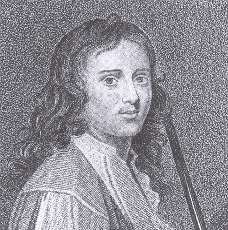Related Research Articles

Richard Brome ; was an English dramatist of the Caroline era.

Michael Mohun was a leading English actor both before and after the 1642–60 closing of the theatres.
Queen Anne's Men was a playing company, or troupe of actors, in Jacobean era London. In their own era they were known colloquially as the Queen's Men — as were Queen Elizabeth's Men and Queen Henrietta's Men, in theirs.
Christopher Beeston was a successful actor and a powerful theatrical impresario in early 17th century London. He was associated with a number of playwrights, particularly Thomas Heywood.

A boy player was a male child or teenager who performed in Medieval and English Renaissance playing companies. Some boy players worked for adult companies and performed the female roles, since women were not allowed to perform on the English stage during this period. Others worked for children's companies in which all roles, not just the female ones, were played by boys.
Beeston's Boys was the popular and colloquial name of The King and Queen's Young Company, a troupe of boy actors of the Caroline period, active mainly in the years 1637–1642.
The Lady Elizabeth's Men, or Princess Elizabeth's Men, was a company of actors in Jacobean London, formed under the patronage of King James I's daughter Princess Elizabeth. From 1618 on, the company was called The Queen of Bohemia's Men, after Elizabeth and her husband the Elector Palatine had their brief and disastrous flirtation with the crown of Bohemia.
Stephen Hammerton was a boy player or child actor in English Renaissance theatre, one of the young performers who specialized in female roles in the period before women appeared on the stage. His case illuminates the conditions of boy actors in this era.
Richard Perkins was a prominent early seventeenth-century actor, most famous for his performance in the role of Barabas in Christopher Marlowe's The Jew of Malta. At the peak of his career in the 1630s, many contemporaries judged Perkins to be the premier tragedian of his generation.
The Renegado, or The Gentleman of Venice is a late Jacobean stage play, a tragicomedy written by Philip Massinger and first published in 1630. The play has attracted critical attention for its treatment of cultural conflict between Christian Europe and Muslim North Africa.
Theophilus Bird, or Bourne, was a seventeenth-century English actor. Bird began his stage career in the Stuart era of English Renaissance theatre, and ended it in the Restoration period; he was one of the relatively few actors who managed to resume their careers after the eighteen-year enforced hiatus (1642–60) when the theatres were closed during the English Civil War and the Interregnum.
King's Men personnel were the people who worked with and for the Lord Chamberlain's Men and the King's Men from 1594 to 1642. The company was the major theatrical enterprise of its era and featured some of the leading actors of their generation – Richard Burbage, John Lowin, and Joseph Taylor among other – and some leading clowns and comedians, like Will Kempe and Robert Armin. The company benefitted from the services of William Shakespeare, John Fletcher, and Philip Massinger as regular dramatists.
Michael Bowyer (1599–1645) was an actor in English Renaissance theatre in the Jacobean and Caroline eras. He spent most of his maturity with Queen Henrietta's Men, but finished his career with the King's Men. With the former company, he was one of "those of principal note," according to James Wright's Historia Histrionica (1699), one of the troupe's "eminent actors."
King John and Matilda is a Caroline era stage play, a historical tragedy written by Robert Davenport. It was initially published in 1655; the cast list included in the first edition provides valuable information on some of the actors of English Renaissance theatre.
William Robbins, also Robins, Robinson, or Robson, was a prominent comic actor in the Jacobean and Caroline eras. During the English Civil War he was a captain in the Royalist army and was killed during the siege of Basing House.
Hugh Clark was a prominent English actor of the Caroline era. He worked in both of the main theatre companies of his time, Queen Henrietta's Men and the King's Men.
William Allen was a prominent English actor in the Caroline era. He belonged to both of the most important theatre companies of his generation, Queen Henrietta's Men and the King's Men.
Anthony Turner was a noted English actor in the Caroline era. For most of his career he worked with Queen Henrietta's Men, one of the leading theatre companies of the time.
William Wintershall, also Wintersall or Wintersell, was a noted seventeenth-century English actor. His career spanned the difficult years of mid-century, when English theatres were closed from 1642 to 1660, during the English Civil War and the Interregnum.
John Sumner was an English theatre actor during the Caroline era (1625–1642).
References
- Bentley, Gerald Eades. The Jacobean and Caroline Stage. Volumes I and II, Oxford, Clarendon Press, 1941.
- Gurr, Andrew. The Shakespearean Stage 1574–1642. Cambridge, Cambridge University Press, 1992.
- Murray, John Tucker. English Dramatic Companies 1558–1642. Boston, Houghton Mifflin, 1910.
- Nunzeger, Edwin. A Dictionary of Actors and of Others Associated with the Representation of Plays in England Before 1642. New Haven, Yale University Press, 1929.
- Stevens, David. "The Stagecraft of James Shirley." Educational Theatre Journal, Vol. 29 No. 4 (December 1977), pp. 493–516.
- Stevenson, Allan H. "James Shirley and the Actors at the First Irish Theatre." Modern Philology, Vol. 40 No. 2 (November 1942), pp. 147–60.